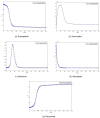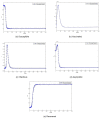Mathematical COVID-19 model with vaccination: a case study in Saudi Arabia
- PMID: 35634103
- PMCID: PMC9137965
- DOI: 10.7717/peerj-cs.959
Mathematical COVID-19 model with vaccination: a case study in Saudi Arabia
Abstract
The discovery of a new form of corona-viruses in December 2019, SARS-CoV-2, commonly named COVID-19, has reshaped the world. With health and economic issues at stake, scientists have been focusing on understanding the dynamics of the disease, in order to provide the governments with the best policies and strategies allowing them to reduce the span of the virus. The world has been waiting for the vaccine for more than one year. The World Health Organization (WHO) is advertising the vaccine as a safe and effective measure to fight off the virus. Saudi Arabia was the fourth country in the world to start to vaccinate its population. Even with the new simplified COVID-19 rules, the third dose is still mandatory. COVID-19 vaccines have raised many questions regarding in its efficiency and its role to reduce the number of infections. In this work, we try to answer these question and propose a new mathematical model with five compartments, including susceptible, vaccinated, infectious, asymptotic and recovered individuals. We provide theoretical results regarding the effective reproduction number, the stability of endemic equilibrium and disease free equilibrium. We provide numerical analysis of the model based on the Saudi case. Our developed model shows that the vaccine reduces the transmission rate and provides an explanation to the rise in the number of new infections immediately after the start of the vaccination campaign in Saudi Arabia.
Keywords: COVID-19; Mathematical model; Stability; Vaccination.
©2022 Algarni et al.
Conflict of interest statement
The authors declare there are no competing interests.
Figures





Similar articles
-
Effect of Pfizer/BioNTech and Oxford/AstraZeneca vaccines against COVID-19 morbidity and mortality in real-world settings at countrywide vaccination campaign in Saudi Arabia.Eur Rev Med Pharmacol Sci. 2021 Nov;25(22):7185-7191. doi: 10.26355/eurrev_202111_27271. Eur Rev Med Pharmacol Sci. 2021. PMID: 34859883
-
Acceptance and Attitude toward COVID-19 Vaccination among the Public in Saudi Arabia: A Cross-sectional Study.J Contemp Dent Pract. 2021 Jul 1;22(7):730-734. J Contemp Dent Pract. 2021. PMID: 34615775
-
Socio-Demographics Correlate of COVID-19 Vaccine Hesitancy During the Second Wave of COVID-19 Pandemic: A Cross-Sectional Web-Based Survey in Saudi Arabia.Front Public Health. 2021 Jun 24;9:698106. doi: 10.3389/fpubh.2021.698106. eCollection 2021. Front Public Health. 2021. PMID: 34249851 Free PMC article.
-
Insights into COVID-19 Vaccine Development Based on Immunogenic Structural Proteins of SARS-CoV-2, Host Immune Responses, and Herd Immunity.Cells. 2021 Oct 29;10(11):2949. doi: 10.3390/cells10112949. Cells. 2021. PMID: 34831172 Free PMC article. Review.
-
The current reproduction number of COVID-19 in Saudi Arabia: is the disease controlled?Environ Sci Pollut Res Int. 2021 Sep;28(33):44812-44817. doi: 10.1007/s11356-021-14217-6. Epub 2021 Jul 9. Environ Sci Pollut Res Int. 2021. PMID: 34244941 Free PMC article. Review.
Cited by
-
Booster Dose Vaccination and Dynamics of COVID-19 Pandemic in the Fifth Wave: An Efficient and Simple Mathematical Model for Disease Progression.Vaccines (Basel). 2023 Mar 3;11(3):589. doi: 10.3390/vaccines11030589. Vaccines (Basel). 2023. PMID: 36992172 Free PMC article.
-
Modeling the dynamics of COVID-19 with real data from Thailand.Sci Rep. 2023 Aug 11;13(1):13082. doi: 10.1038/s41598-023-39798-9. Sci Rep. 2023. PMID: 37567888 Free PMC article.
-
Modeling the Spread of COVID-19 with the Control of Mixed Vaccine Types during the Pandemic in Thailand.Trop Med Infect Dis. 2023 Mar 16;8(3):175. doi: 10.3390/tropicalmed8030175. Trop Med Infect Dis. 2023. PMID: 36977177 Free PMC article.
-
Optimal COVID-19 epidemic strategy with vaccination control and infection prevention measures in Thailand.Infect Dis Model. 2022 Dec;7(4):835-855. doi: 10.1016/j.idm.2022.11.002. Epub 2022 Nov 21. Infect Dis Model. 2022. PMID: 36438694 Free PMC article.
References
-
- Aldila D, Khoshnaw SH, Safitri E, Anwar YR, Bakry AR, Samiadji BM, Anugerah DA, GH MFA, Ayulani ID, Salim SN. A mathematical study on the spread of COVID-19 considering social distancing and rapid assessment: the case of Jakarta, Indonesia. Chaos, Solitons & Fractals. 2020;139:110042. doi: 10.1016/j.chaos.2020.110042. - DOI - PMC - PubMed
-
- Alexander ME, Moghadas SM. Bifurcation analysis of an SIRS epidemic model with generalized incidence. SIAM Journal on Applied Mathematics. 2005;65(5):1794–1816. doi: 10.1137/040604947. - DOI
-
- Asamoah JKK, Jin Z, Sun G-Q, Seidu B, Yankson E, Abidemi A, Oduro F, Moore SE, Okyere E. Sensitivity assessment and optimal economic evaluation of a new COVID-19 compartmental epidemic model with control interventions. Chaos, Solitons & Fractals. 2021;146:110885. doi: 10.1016/j.chaos.2021.110885. - DOI - PMC - PubMed
-
- Asamoah JKK, Nyabadza F, Jin Z, Bonyah E, Khan MA, Li MY, Hayat T. Backward bifurcation and sensitivity analysis for bacterial meningitis transmission dynamics with a nonlinear recovery rate. Chaos, Solitons & Fractals. 2020;140:110237. doi: 10.1016/j.chaos.2020.110237. - DOI
LinkOut - more resources
Full Text Sources
Miscellaneous
